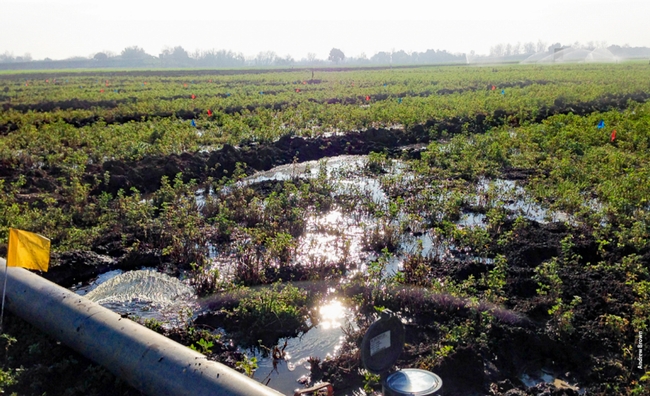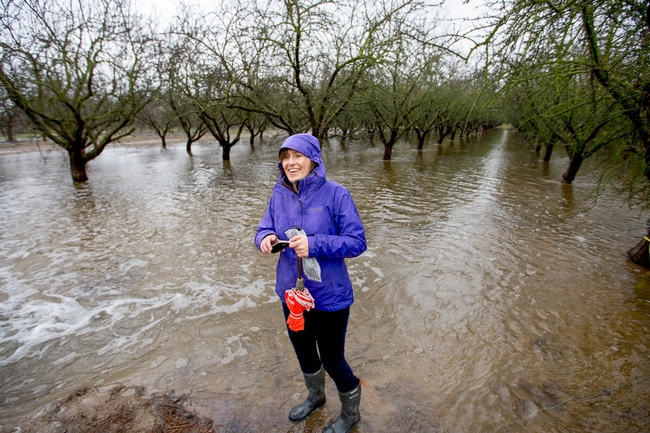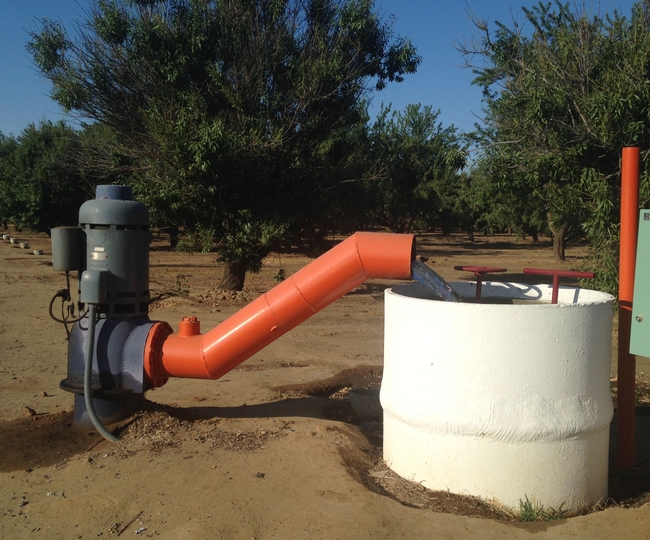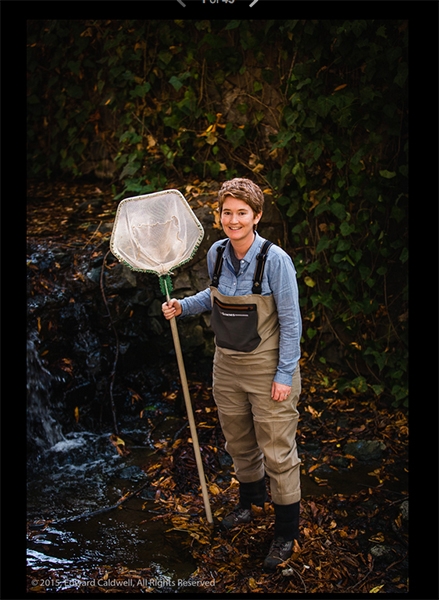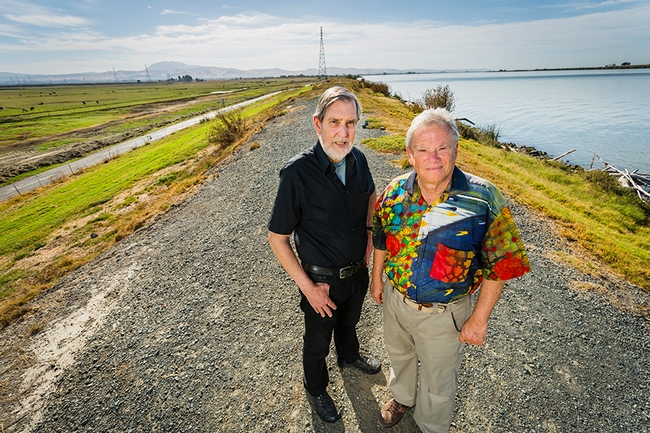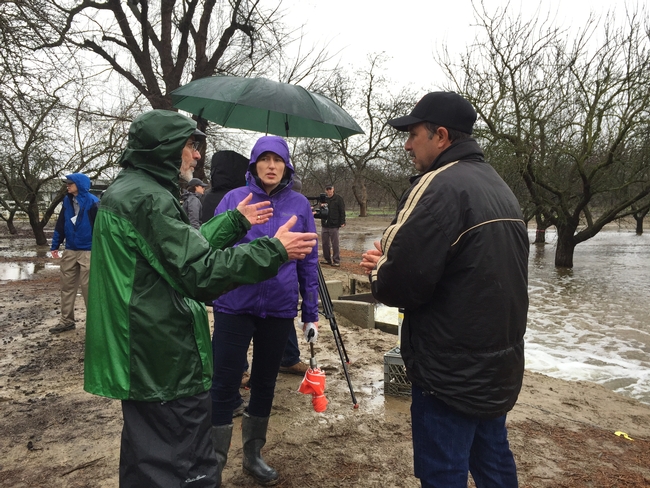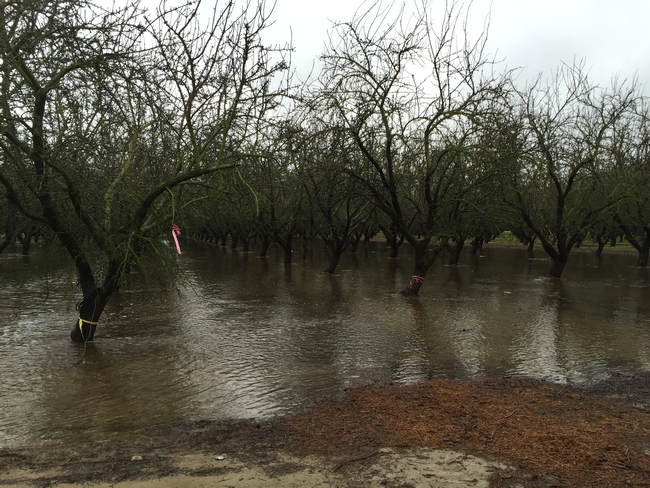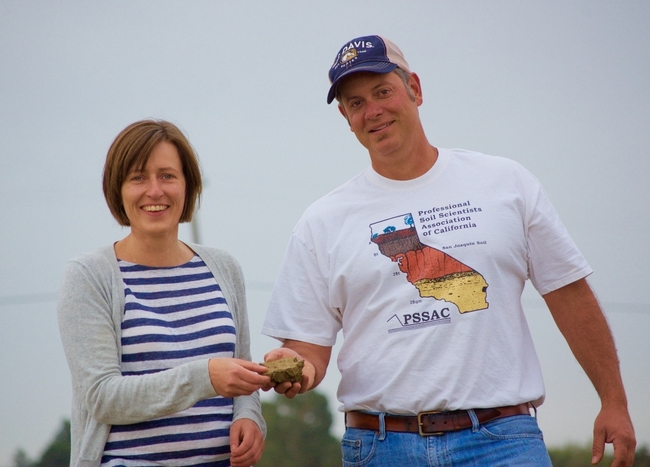Posts Tagged: groundwater
Flooding alfalfa fields has high potential for groundwater recharge
A rigorous field study in two California climate zones has found that alfalfa can tolerate very heavy winter flooding for groundwater recharge. The research was published online Jan. 16 in California Agriculture journal.
The alfalfa research is the latest in a series of projects studying the effects of using land planted with permanent crops – including almond orchards and vineyards – to capture and bank winter storm water. Such projects have great promise but also require collaboration across multiple jurisdictions and agencies. UC Agriculture and Natural Resources vice president Glenda Humiston has made groundwater recharge on working lands and open spaces a division priority and is working with water and land use leaders around the state to facilitate it through policy recommendations and cross-agency collaboration.
Groundwater is a critical water reserve in California, particularly during droughts when surface water supplies are low. Water slowly filled California's aquifers over tens of thousands of years. Beginning in the early 20th century and continuing in the present day, groundwater has been consistently withdrawn at a higher rate that it can be replenished naturally. In 2014, the California Legislature enacted the Sustainable Groundwater Management Act, which requires all critically overdrafted groundwater basins to have a groundwater sustainability plan in place by 2020.
Flooding agricultural land during the winter, when surplus surface water is often available, is one promising strategy for replenishing overdrafted aquifers.
View a four-minute video about on-farm flooding for groundwater recharge on the UCTV Sustainable California channel. In the video, Professor Helen Dahlke discusses the work she and her fellow UC Davis researchers, UC Cooperative Extension advisors and specialists, and California farmers are undertaking to test the impacts of irrigating almond orchards in the winter to recharge groundwater.
For the alfalfa flooding research, UC Davis and UC Cooperative Extension scientists flooded two established alfalfa stands, one near Davis and one in the Scott Valley, Siskiyou County, during the winters of 2015 and 2016. The sites were selected because the soils in those areas have relatively high water percolation rates.
“We found that most of the applied water percolated to the groundwater table,” wrote lead author Helen Dahlke, integrated hydrologic science professor at UC Davis.
The alfalfa endured saturated conditions in the root zone for a short time, but the yield loss was minimal.
Dahlke and her co-authors – USDA Natural Resources Conservation Service soil scientist Andrew Brown, and UC Cooperative Extension specialists Dan Putnam and Toby O'Geen and the late UCCE advisor Steve Orloff – noted that the positive results of the alfalfa trial show tremendous potential for the state's groundwater basins. Using an index created by O'Geen that identifies the locations of California soils suitable for on-farm groundwater recharge, the scientists calculated the potential groundwater recharge. If all the suitable alfalfa acreage were flooded with six feet of winter water, and assuming 90 percent percolates past the root zone, it would be possible to bank 1.6 million ac-ft. of groundwater per year.
“For reference, the Oroville reservoir, second largest in the state, has a storage capacity of 3.5 million ac-ft.,” Dahlke wrote.
Leigh Bernacchi, program coordinator of UC Water at UC Merced, interviewed Helen Dahlke to get more details on groundwater recharge strategies for California. Read the Q&A on the UC Water Center website.
Additional reading:
- Map identifies farmland with potential for groundwater recharge
- Flooding farms in the rain to restore groundwater
- On-farm flood capture could reduce groundwater overdraft in Kings River Basin
- Desperate Times Call for Sensible Measures: The Making of the California Sustainable Groundwater Management Act
California's new groundwater law leaves unanswered questions
The Sustainable Groundwater Management Act (SGMA) is a revolutionary law that will have profound impacts on the state's agriculture industry, however, it also leaves out many implementation details, according to Michael Kiparsky, director of the Wheeler Water Institute at UC Berkeley. Kiparsky authored the article Unanswered questions for implementation of the Sustainable Groundwater Management Act, which was published online by California Agriculture journal.
"SGMA is unprecedented, hugely impactful and a work in progress," Kiparsky said in a videotaped keynote presentation at the 2nd International Groundwater and Agriculture Conference in June 2016. The California Agriculture article is based on his remarks at the conference.
Kiparsky said SGMA defines sustainable management as avoidance of six specific undesirable results:
- Lowering of groundwater levels
- Reduction in groundwater storage
- Seawater intrusion
- Water quality degradation
- Land subsidence
- Impacts on beneficial uses of interconnected surface waters
SGMA relies on local control, with an "enforcement backstop" provided by the State Water Resources Control Board. New local entities called groundwater sustainability agencies (GSAs) will implement SGMA.
In the article, the author outlined what he considers the 7 most important unknowns about California's water future under SGMA.
- Governance. Decisions about governance and institutional design are being made now, so immediate attention to this question is imperative, he said.
- Translating sustainability goals into practice. "In many of the 127 groundwater basins governed by SGMA, the status quo is simply unsustainable," Kiparsky said. "The amount and patterns of groundwater use will need to change."
- Groundwater-surface water interactions. "Many groundwater users are expecting to augment water supplies by buying water within the basins or outside. Markets can be excellent tools for efficiency," he said.
- The role of markets. "Whether and how GSAs can design effective and fair markets as part of their efforts to achieve sustainability will be quite fascinating to observe," Kiparsky said.
- The role of data. SGMA empowers, but does not require, GSAs to collect groundwater extraction data from individual wells. The law requires only aggregated extraction data to be shared and reported to the state.
- The role of the State Water Board. Serving as "backstop" enforcement to the GSAs is a new role for the Board. "We don't know how it will approach the role in practice," Kiparsky said.
- "Significant and unreasonable." SGMA calls to avoid significant and unreasonable impacts, but it doesn't define the meaning of "significant and unreasonable." GSAs will need to define the terms themselves.
Kiparsky ended his article on a positive note with examples of research projects already underway aimed at helping meet the goals of SGMA legislation.
"Both projects illustrate how SGMA already is forcing and enabling creative thinking," Kiparsky said. "This type of creative thinking will be critical for California to implement SGMA successfully and transform from a national laggard in groundwater management into an international leader."
California Agriculture journal is the peer-reviewed research journal of UC Agriculture and Natural Resources.
California’s delta: On the front lines of the state’s water issues
California water: Few natural resources are as impressive, or as imperiled. Whether it's supplying 40 million domestic users, cooling the server farms of Silicon Valley, or irrigating the actual farms that supply half of the nation's produce, the importance of the state's aquifers and headwaters cannot be overstated. (Lake Tahoe, Yosemite Falls, and white-water rafting on the Kern and American Rivers feel like an embarrassment of riches.) While the potential for a multi-decade drought has grabbed headlines, however, California's water supply faces assault from a host of lesser-known factors including infrastructure failure, pollution, habitat loss, and plain old political chaos. This issue is strongly interdisciplinary, so it's only natural that UC Berkeley College of Natural Resources professors and students have been at the forefront of analyzing the problems and beginning the search for solutions. Several Berkeley professors have even served on the Delta Independent Science Board (DISB), a group of experts appointed by the state to oversee the quality of scientific research on California's contentious delta water issues.
Supply vs. demand
“Issue number one, one, and one is that a substantial portion of the acreage in agriculture is supported through groundwater overdraft, even in normal-rainfall years,” he says.
According to the U.S. Geological Survey, California's cities, factories, and farms soak up about 38 billion gallons every day. And while most people think of water in terms of rivers, lakes, and rain, over a third of the state's supply comes from aquifers deep underground. Only one in six Californians relies on groundwater alone to supply their domestic needs.
“We've been mining water to expand use beyond surface-water allocations,” says Norgaard. “Groundwater is close to gone, and agriculture is saying, ‘Where's our water, where's our water, where's our water?'”
Given that much of California is a desert — and that decades-long droughts are not impossible — intelligently managing California's limited supply is crucial. Gov. Jerry Brown recently ordered municipalities to cut home water usage by a whopping 25 percent, and California residents gave themselves a well-deserved pat on the back when usage for July 2015 surpassed that target by 6 percent. But there's one problem: Domestic use accounts for only 10 percent of California's total water consumption. Agricultural use, on the other hand, accounts for closer to 40 percent.
At first glance, that doesn't seem entirely inappropriate. Fruits, vegetables, and nuts, not to mention Northern California's incomparable wine and cheese — why shouldn't the farmers who feed half of the nation take half of the water that the state has to offer?
“Do you know what percent of the state's economy is agriculture?” asks Vincent Resh, a professor in the Department of Environmental Science, Policy, and Management (ESPM) and another DISB member. “Less than 2 percent.” It's a very vocal 2 percent, though, and there are volumes of case law — and a good amount of political muscle — dedicated to maintaining the status quo. “I'm very sympathetic toward the plight of farmers in the delta,” Resh continues. And farmworkers are the poorest of California's poor, with seasonal unemployment rates reaching upwards of 60 percent. “It's the human side of the story that I've become extremely sensitive about.”
Nonetheless, Resh recalls being on a delta tour that was packed with people who identified themselves as delta farmers.
“They were all talking about how this has been their family heritage for generations, but they were working as lawyers and bankers," Resh said. "They were really talking about a way of life that was long gone for them personally, but a memory that they were holding on to. Actually, this ‘way of life' idea is true of many of the contentious water issues in California. The controversies over who gets the water in the Klamath River in Northern California and Oregon are as much about way of life as they are about water for agriculture and salmon.”
A fragile water system
Nobody is suggesting an outright end to farming in California, but it's becoming increasingly clear that change is coming. One looming problem is the fragility of the levee system. Drive around Sacramento's rural environs and you'll realize that a lot of farmers actually do their work below sea level, with nothing but a hodgepodge system of peat dams and concrete rubble to restrain the brackish delta waters. Overactive beavers, like the one on the Jones Tract, are the least of the problem.
Like everyone else in California, the engineers who watch over the delta's levee system are at the mercy of probability, breathing a sigh of relief every day that goes by without the catastrophic shaking of the Big One.
“In any given year, there's not a large chance of a huge earthquake,” says David Sunding, UC Agriculture and Natural Resources Cooperative Extension specialist and chair of the UC Berkeley Department of Agricultural and Resource Economics. “But those risks accumulate over time. And by the time you look two decades into the future, there's a two-thirds chance of a very large quake that will affect the delta's water system.”
Even an apparent bounty — consecutive years of high rainfall — poses risks. River flows would rise along with reservoir levels, placing added stress on levees so that even a minor structural failure could set off a chain reaction, flooding fields and devastating crops.
“The current proposals for achieving reliable water supply and ecosystem health may be controversial, but it's clear that something has to be done — we can't have the status quo.”
— Vincent Resh
Inherent in either of these scenarios is the threat to drinking water. The delta houses the State Water Project, two massive pumps that send water to Southern California. If the levees are overtopped, the salt water of the bay will infiltrate the Sacramento and San Joaquin rivers, rendering the supply undrinkable.
“The worst-case scenario is three months without water,” Resh said. “And that's from Fremont down. Silicon Valley, Los Angeles, everything.”
Not just a human problem
Of course, farmers and thirsty urbanites aren't the only ones who need water. According to Berkeley Environmental Science, Policy, and Management associate professor Stephanie Carlson, “many of California's native fishes are declining, and the causes are rooted in habitat loss and the introduction of non-native fishes into California's waterways.” She emphasizes that our current multiyear drought may be the “nail in the coffin” for those populations already facing extinction.
Carlson's research focuses on understanding where and why fish populations are persisting. She found that several native fish, including commercially harvested salmon, live in “intermittent streams” — waterways that flow continuously in the wintertime but break into isolated pools during periods of low rainfall. As drought or human usage reduces stream flow, water quality deteriorates, resulting in higher temperatures and less oxygen. In pools that dry up completely, all fish die, of course, but some “refuge” pools persist through the summer — and these habitats do support fish.
Carlson's team has found that “the survival of imperiled salmon and trout varies among summers, but is highest after wet winters.” Following wet winters, streams flow longer into the summer, more pools persist, and water quality is improved. But, interestingly, “almost regardless of winter rainfall, most fish mortality is concentrated in late summer,” meaning that early, abundant fall rains may be as important as the previous winter's storms.
Carlson believes that these findings should guide management. Urban development in the Bay Area is spreading from flatlands to the hills.
“We need to focus our conservation efforts in those upper headwater streams — many of which are intermittent,” she says. Carlson also stresses that native fish have adapted to the seasonal shift from flowing streams to standing pools, while non-native fish have not — thus intermittent headwater streams may be important refuges for native fishes.
While diverting less water from streams during summer might help juvenile salmon, managing outcomes in the ocean is far more difficult. In 2007 and 2008, the West Coast Chinook salmon population collapsed, with the Sacramento River fall run reduced by 90 percent. Fisheries closed at a cost of millions of dollars, and the federal government declared a disaster. While the crisis was attributed to low ocean productivity beyond human control, human degradation of freshwater salmon habitats worsened the impact of poor ocean conditions.
Most salmon-breeding habitats in the Central Valley lie upstream of dams. Today, most Central Valley salmon are born in hatcheries; many circumnavigate the delta in trucks and are released into the San Francisco Bay. Because these fish don't swim through their natal rivers and the delta, they have no way to retrace their paths as adults. So they go everywhere, mingling with the broader gene pool. This “straying” erodes genetic differences among populations and increases the risk of collapse. It's possible that a more vibrant, genetically diverse salmon population could have better resisted the environmental disturbances of the mid-2000s.
“It's like having a broad portfolio of financial investments, as we've been taught with our 401(k)s,” Carlson says. “Maintaining multiple distinct populations with diverse traits and dynamics provides insurance against environmental change.”
—Excerpted from an article in the winter 2016 issue of Breakthroughs Magazine. Read the complete article.
Researchers study farm field flooding for aquifer recharge
UC ANR Cooperative Extension specialist Toby O'Geen was the lead author of research published in California Agriculture journal that identified agricultural lands in California suitable for flooding in order to bank groundwater. He has created an app that allows landowners across the state to assess the suitability of their property for groundwater banking.
The Modesto project will determine what impact winter flooding will have on the health of almond trees and almond yield. UC ANR Cooperative Extension advisor Roger Duncan was quoted in the Los Angeles Times about the potential advantages and disadvantages of flooding crops in the winter. He said water could spur more fungal diseases, but could also drown out worms and mites that damage crops.
The Almond Board of California is funding the project, anticipating that certain almond orchards will be good candidates for groundwater recharge.
"Almond orchards have good soil characteristics, and water delivery systems are already in place,” said Bob Curtis, director of agriculture affairs for the almond board. “Winter flooding should actually benefit the trees while replenishing groundwater to benefit us all."
Following are recent articles about the project:
Researchers test a possible drought solution by flooding an almond farm
Geoffrey Mohan, The Los Angeles Times, Jan. 20, 2016
(Reprinted in Daily News 24/7)
Scientists flood almond orchards to restore groundwater in California
Capital Public Radio, Jan. 20, 2016
Stormwater floods Modesto almond orchard in experiment to restore aquifer
San Jose Mercury News, Jan. 19, 2016
(Reprinted in the Contra Costa Times)
Researchers show off groundwater recharge near Modesto
Modesto Bee, Jan. 20, 2016
(Reprinted in the Fresno Bee and Bloomberg Business)
UC Davis scientists flood Modesto orchards in hopes of finding way to restore groundwater
CBS13, Sacramento and Modesto affiliates, Jan. 20, 2016
Researchers test a possible drought solution by flooding an almond farm
KTLA News 5, Jan. 20, 2016
(Rebroadcast on KRQE News 13)
Orchard tries experiment to restore aquifer
Morning Ag Clips, Jan. 20, 2016
Almond orchard key to water banking experiment
AgraNet, Jan. 20, 2016
Groundwater banking captures the media's imagination
With rain falling, interest in UC Agriculture and Natural Resources (UC ANR) research on groundwater banking has been high. In California Agriculture journal, UC ANR Cooperative Extension specialist Toby O'Geen and 13 co-authors shared research on California soils that showed which areas in the state were best suited for water to be percolated down into an aquifer.
The article included a map of California with color coded areas indicating areas that were excellent for groundwater banking down to poor. The story was picked up widely by the news media.
California farmers will intentionally flood their fields this winter
Jane Braxton Little, Scientific American
For two months this winter, a team of scientists will flood almond orchards in the Central Valley to a depth of two feet by redirecting rainfall through a network of ditches originally designed to divert floodwater away. To measure success, they will then monitor how much water filters into the water table over the course of two years. If the method pans out, pear, plum and walnut tree orchards might also benefit from intentional flooding, according to a recent study led by UC ANR Cooperative Extension specialist Anthony O'Geen.
Map identifies farmland with greatest potential for groundwater recharge
Diane Nelson, UC Davis News Service
This December, O'Geen and a team of scientists - including Helen Dahlke, professor in integrated hydrologic sciences at UC Davis - will flood almond fields in the Central Valley, building on research that suggests that deliberately flooding farmland in winter can replenish aquifers without harming crops or drinking water. “Adding an extra few feet of water to even just 10 percent of California's cropland this winter could add an additional 3 million acre-feet of groundwater,” Dahlke said. “That could go a long way toward replenishing the 6 million acre-feet growers had to pump this year alone to cope with California's drought.”
UC scientists test inexpensive way to capture El Niño rains
Amy Graff, The San Francisco Chronicle (SFGate.com)
Researchers from UC Davis and UC Cooperative Extension are testing a new method for capturing some of that underutilized water by diverting it from rivers into the network of canals running through Central Valley farmland. "That could go a long way toward replenishing the 6 million acre-feet growers had to pump this year alone to cope with California's drought," said Dahlke, who's testing the technique in the field. UC ANR Cooperative Extension specialist O'Geen points out that this is a win-win for agriculture. "They're typically considered the bad guys. They're feeding the world yet they're considered the water hogs because they have to take all the water to grow the food. On-farm recharge offers the opportunity for them to offer two services — providing food and collecting water. That puts agriculture in a better light."
How California could get smarter about droughts and flooding
Nathaneal Johnson, Grist.org
Land suitable for flooding should be flat, free of contamination and clear of structures. O'Geen estimates that leaves 3.6 million acres. “A preliminary calculation based only on soil properties and crop type shows that landscapes rated Excellent or Good could be used to bank as much as 1.2 million acre feet of water per day.” UC ANR groundwater hydrologist Thomas Harter was also a source in the article. He said there are additional challenges to overcome, including reluctant farmers, variations in soil profile, red tape and a lack of infrastructure, especially on farms that now use micro sprinklers or drip irrigation systems, rather than flood.
California farmers hope to capture El Niño rains
David Dienick, KCRA 3 News
Researchers have been looking for ways to capture more runoff without relying on reservoirs. "We've never actually managed our agriculture landscapes for groundwater recharge to my knowledge," O'Geen said.
Farmers urged to flood their fields with any upcoming rain
KFBK News Radio
A soil map has been developed that will allow farmers to take advantage of every opportunity to recharge the groundwater. "Is it a managed event where we are giving a couple extra irrigations in the winter time and the wet crops can tolerate a few extra irrigations when they don't really use the water," O'Geen said.
Another study suggests flooding farmland to recharge aquifers
Tim Hearden, Capital Press
A study in Merced, Madera and Fresno counties will determine whether diverting excess river flows from winter storms to farmland successfully. In addition, O'Geen and Dahlke plan to use some of the state's 3.6 million acres of farms and ranches with suitable topography and soil conditions to recharge aquifers during winter months. Dahlke is still conducting field experiments to evaluate how much water can be recharged in a couple of weeks.
UC maps farmland that can 'bank' groundwater during El Niño rains
KPCC 89.3
In response to California's withering drought and a dwindling water supply, researchers at UC Davis have identified farmland that could potentially "bank" groundwater during what is predicted to be an unusually wet winter. "A lot of growers are interested in learning how they can help improve the groundwater situation in California," O'Geen said. "The index provides details on the groundwater-recharge potential for any parcel, which you can search for by address or access using your device's GPS."


